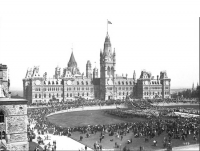22 June 1897
Queen Victoria was our longest reigning monarch until her record of 63 years, seven months was eclipsed by that of Queen Elizabeth II in 2015. When Victoria celebrated her Diamond Jubilee, marking 60 years on the throne in 1897, the British went wild with joy. They had lots to celebrate. During her reign, Britain had been transformed. The nation had undergone an industrial revolution that had sharply raised national income. Electricity illuminated city streets and was beginning to light British homes. The telephone and the telegraph provided rapid communications, while railways and fast steamships moved people and goods effectively and efficiently around a British Empire that covered a sixth of the globe. This is not to say Victoria personally had much to do with all this, but she was the symbol of British achievement. There were clouds on the horizon, however. Germany and the United States were both challenging Britain on multiple fronts. And trouble was brewing in South Africa with the Boers. But in that glorious summer of 1897, Britain was on top of the world, economically, militarily, and politically. The Queen’s 60th anniversary on the throne was a good opportunity to celebrate. Although the actual anniversary date of her accession was Sunday, 20th June 1897, the official celebrations took place on Tuesday, 22nd June—declared an Empire-wide holiday.
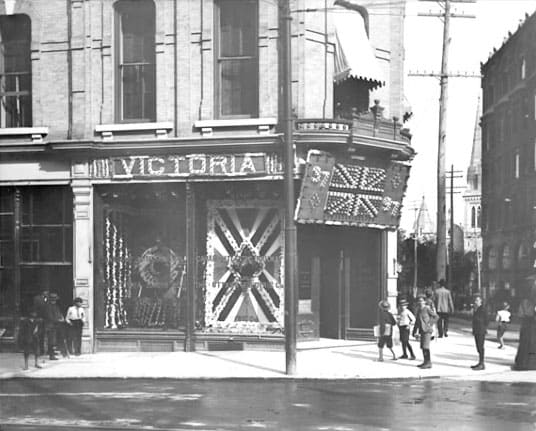 SE Corner of Sparks & Elgin, Front entrance of the office of the Canada Atlantic Railway Company
SE Corner of Sparks & Elgin, Front entrance of the office of the Canada Atlantic Railway Company
Topley Studio, Library and Archives Canada, PA-027878In Ottawa, preparations for the celebrations began weeks before the big day. The Capital bedecked itself in festoons of red, white and blue bunting and flags. For the patriotically minded, John Murphy & Co. sold bunting at 5 1/2 cents per yard. Large flags went for 15 cents, while a bust of the Queen could be had for 39 cents, marked down from 75 cents. For those who could afford it and were connect to the grid, electric lights were the way to go. Thousands of electric lights were strung along streets, and on store fronts at a cost of 10 cents per light, and 25 cents per light installation. So many were the lights, they strained the capacity of the Ottawa Electric Company. On Parliament Hill, the Centre Block was completely illuminated. Above the main entranceway into the Victoria Tower was a massive circle of lights surmounted by a crown, enclosing the letters “V.R.I.” for Victoria Regina Imperatrix. On the top floor of the far western tower was a crown surrounded by a circle of lights. In the three small windows beneath was “1837.” This was matched by a circle of lights around a star with “1897” in the three small windows in the second western tower. Between the two dates were the words “Dieu sauve la Reine.” This decorative motif was repeated on the eastern side of the building but with the words “God save the Queen.”
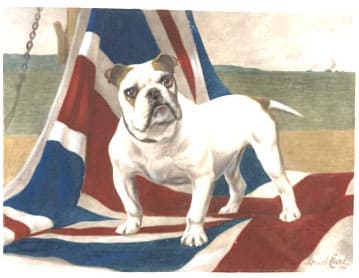 Dimboola, the mastiff, by Maud Earl "What we have, we'll hold
Dimboola, the mastiff, by Maud Earl "What we have, we'll hold
Canadian War Museum, 1896City streets were also illuminated. According to the Journal newspaper, “Sparks Street never looked gayer.” Flags lined both sides of the thoroughfare. Coloured streamers crossed the street from Sappers’ bridge to the Upper Town market (Lyon Street).” A “myriad” of lights lit up the street “like stars along the milky way.” The best display was reportedly at the office of the Canada Atlantic Railway at the corner of Sparks and Elgin Streets. Picked out in red, white and blue lights was a Union Jack over the front door, with the figures “37” and “97” on either side. The lights switched on and off giving the impression that the flag was waving. The words “Victoria” and “Regina” were written in electric lights at the top of the store windows on either side of the main door. In the Sparks Street window was the front of a railway engine, its cowcatcher covered with lights. On the front of the boiler were the dates 1837 and 1897 below the letters “V.R.” Next to the engine was the Queen’s portrait in a diamond-shaped frame surrounded by lights.
Wilson & Sons Art Store on Sparks Street displayed a striking patriotic print of a painting by Maud Earl of the mastiff champion “Dimboola” standing defiantly on a Union Jack with war ships in the background. The inspiration for the painting was a speech by Joseph Chamberlain, a popular British imperialist, in the House of Common in London who said “What we have we’ll hold.” The print was later purchased by Colonel Sherwood and given to the officers’ mess of the 43rd Battalion stationed in Ottawa.
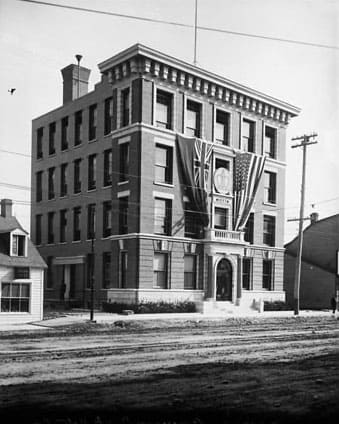 Queen Victoria Jubilee American Bank Note Company
Queen Victoria Jubilee American Bank Note Company
Topley Studio LAC-PA-027912The bank buildings that lined the south side of Wellington Street were also decorated in electric lights. Most chose variants of “V.R.I.,” crowns, or stars. The Union Bank had both, adding the words “The Queen God Bless Her” for good measure. The Quebec Bank was a bit more original opting for a diamond surrounding the figure “60.” The American Bank Note Company was decorated by two large flags, one British and one America on either side of an electrically-lit crown. On Elgin Street, Ottawa’s city hall was decorated with a large crown inside a circle of electric lights as well as “chromos” (colour prints) of the Queen and various British emblems, with flags, colourful bunting and festoons of lights.
British American Bank Note Company, Wellington Street, decorated for Queen Victoria’s Jubilee, June 1897. Note that the street is not asphalted. Topley Studio, Library and Archives Canada, PA-027912.
Jubilee celebrations began on the Saturday with the release of Canada’s first issue of commemorative stamps–two portraits of the Queen, one as a teenager on her accession and the other as an elderly woman. There was a huge crush of people at the Ottawa post office all trying to buy stamps as souvenirs. Many went home disappointed as the supply was very limited, especially of the one half and six cent stamps. All were gone within an hour of the post office’s opening. Reportedly, premiums were being paid by people to acquire them.
On the Sunday, the actual anniversary of Queen Victoria’s accession, churches across the city held Thanksgiving Services. That afternoon at 4pm, the Sons of the Empire sang God Save the Queen. Orders had gone out to all the lodges around the Empire to sing at that hour, starting in Fiji, “the exact antipodes to England.” Afterwards, the Sons of the Empire and other societies, including the Caledonian Society and the Boys’ Brigade, marched in a parade through Ottawa streets.
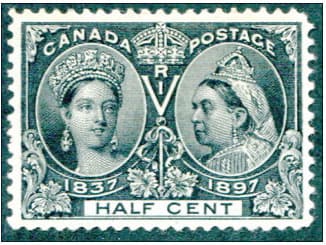 Queen Victoria 1/2 cent Canadian postage stamp, Canadian Commemorative Issue for Queen Victoria's Diamond Jubilee, 1987On that Sunday, the Evening Journal ran a fascinating story on the reminiscences of old timers looking back at Queen Victoria’s accession to the Crown in 1837. Captain Thomas Jones, who arrived in Bytown in 1827 as a young boy, recounted that the news reach the community six or seven weeks after the event. At that time, Bytown boasted a population of just 2,000 souls—300-400 in Upper Town and 1,600-1,800 in Lower Town—apart from the “canallers” who lived in mud and wooden shanties along the canal. Jones recalled that some soldiers would have preferred her uncle, the Duke of Cumberland, to have become the Sovereign. They expressed “strong feelings against a woman, especially a young one,” assuming the Crown. Paradoxically, he added that “loyalty was always prominent.” Rev. John Gourley of Nepean Street said Bytown residents were “reaping the wheat and saving the last of the hay” when the news finally reached them. In church, people were still praying for health of the old king, and the royal family, including Princess Victoria. The news, when it finally came, was, however, overshadowed by the Rebellion of 1836-37. But “there was not a man in the land so rebellious as not to pray sincerely for the best health, longest peaceful reign, and the greatest prosperity.” He added that in 1837 the city centre was a duck pond, Bank Street was a cedar and ash swale, and the garrison just a few stone huts. Another senior citizen, John Joyce of Henry Street, recalled that a celebratory bonfire had been lit at the corner of Nicholas and Rideau Streets, and everybody was there. “Cheer after cheer went up in honour of the youthful Queen.”
Queen Victoria 1/2 cent Canadian postage stamp, Canadian Commemorative Issue for Queen Victoria's Diamond Jubilee, 1987On that Sunday, the Evening Journal ran a fascinating story on the reminiscences of old timers looking back at Queen Victoria’s accession to the Crown in 1837. Captain Thomas Jones, who arrived in Bytown in 1827 as a young boy, recounted that the news reach the community six or seven weeks after the event. At that time, Bytown boasted a population of just 2,000 souls—300-400 in Upper Town and 1,600-1,800 in Lower Town—apart from the “canallers” who lived in mud and wooden shanties along the canal. Jones recalled that some soldiers would have preferred her uncle, the Duke of Cumberland, to have become the Sovereign. They expressed “strong feelings against a woman, especially a young one,” assuming the Crown. Paradoxically, he added that “loyalty was always prominent.” Rev. John Gourley of Nepean Street said Bytown residents were “reaping the wheat and saving the last of the hay” when the news finally reached them. In church, people were still praying for health of the old king, and the royal family, including Princess Victoria. The news, when it finally came, was, however, overshadowed by the Rebellion of 1836-37. But “there was not a man in the land so rebellious as not to pray sincerely for the best health, longest peaceful reign, and the greatest prosperity.” He added that in 1837 the city centre was a duck pond, Bank Street was a cedar and ash swale, and the garrison just a few stone huts. Another senior citizen, John Joyce of Henry Street, recalled that a celebratory bonfire had been lit at the corner of Nicholas and Rideau Streets, and everybody was there. “Cheer after cheer went up in honour of the youthful Queen.”
Tuesday, 22 June 1897 dawned to perfect weather—bright sunshine, warm and a refreshing breeze, though later there were some complaints of dust kicked up from unwatered city streets. (Most streets were still unasphalted.) At 7.59am, the bells at St. Patrick’s church began ringing, followed by those at St. George’s, and the Basilica. Within moments, thirty churches had joined in the peel. The whistle at E.B. Eddy’s then began to blow, and was shortly joined by factory and shop whistles across the city, followed locomotive horns at the train depots. The church bells continued at intervals for the next half hour, while the E.B. Eddy whistle went continuous for nine minutes. Adding to the cacophony was the barking of dogs and the shouting and cheering of Ottawa residents standing in front of their homes waving flags.
At 9am, a 1,000-man parade of the St. Jean Baptiste Society set out on a procession through the streets of Ottawa after a celebratory Mass at the Basilica to demonstrate “what loyalty exists in the hearts of French Canadians towards Her Majesty the Queen.” At the head of the procession was Monsieur F. Laroque, the grand marshal of the Society as well as the grand marshals of the Artisans. The Saint Anne band played marching tunes while various other societies that had joined the parade carried banners and flags.
Later in the day, 8,000 children—6,000 from Ottawa and 2,000 from Hull—dressed in white or pale blue with red, white and blue trimmings, waving tiny Union Jacks, assembled on Parliament Hill. The Upper Town children had walked from Central West School with each class headed by their teacher, and each school headed by their principal. Lower Town children began their march to the Hill from the Byward Market. Separate school children were led by grey-gowned nuns. The children took their position on either side of the central walkway in front of the Centre Block where a large decorated stage had been erected. The dignitaries present for the event included the Governor General, Lord Aberdeen and senior Cabinet ministers, and civic leaders. Wilfrid Laurier, the Prime Minister, was absent. He was in London participating in the Queen’s parade as a guest of honour. He was knighted the same day.
Lord Aberdeen, wearing the uniform of a Lord Lieutenant with the star of a baronet of Nova Scotia and other honours pinned to his chest, spoke to the children and a crowd of 25,000 people about the Queen’s life of service, her dedication to duty, and the example she set for others. He also read out loud the Queen’s blessings and thanks to “my beloved people” in Canada, that he had received earlier that morning. Following a tremendous cheer from the crowd, he read out his response saying that Her Majesty’s “most gracious and touching message” will “stir afresh hearts already full.” To provide a lasting tribute to the Queen, Lord Aberdeen announced the establishment of the Victorian Order of Nurses to be dedicated to help and relief of the sick and lonely.
Following other speeches, Professor Birch of the College of Music stood on a chair and raised his baton—the signal for the Bandmaster McGillicuddy of the 43rd Battalion to sound the key for the National Anthem. Upon the third beat, the massed choir of children from Ottawa and Hull began to sing “God Save the Queen.” After singing the anthem twice through, “three cheers” were given to the Queen and Lord Aberdeen.
Later at Cartier Square by the Drill Hall, the 43rd Battalion held an inspection and completed complicated military practices, including sword drill, pursuit exercises on horseback, and independent firing drill. The battalion, accompanied by a company of Fenian Raid veterans, also did a “march past.” Crowds of onlookers stood five and six persons deep around the Square to witness the military manoeuvres. The Journal commented that “the main part of the rising generation occupied reserved seats on the trees and telephone poles.” Lord Aberdeen presented the Royal Humane Society medal to Pte Douglas Lyon of the 43rd Battalion for bravery in attempting to save the lives of two young boys who drowned after falling through the ice while skating on the Rideau Canal at the end of November the previous year. This was followed by a 21-gun Royal Salute by the Ottawa Field Battery from Nepean Point.
The afternoon of Jubilee Day was taken up by sporting events at Lansdowne Park, including a lacrosse match between the Capitals and the Shamrocks. The Capitals emerged victorious 6-1. After sundown, Ottawa residents and visitors strolled around downtown streets to admire the illuminated buildings. There was, however, a lighting glitch on Parliament Hill. When the lights were switched on shortly before 9pm, a portion stayed dim. Fortunately, the problem was quickly rectified. Musical entertainment was provided on the big stage in front of the Centre Block. Madame Arcand opened, singing a solo of The Land of the Maple. She was joined by a 300-voice choir. Other patriotic songs sung by other vocalists included: Hearts of Oak, British Tailors’ Toast and, of course, Rule Britannia. Mr. Choquette MP followed with Dieu Brigadier in French. A Highland Pipes band also played a number of tunes, followed by Scottish dances.
At 10pm, the fireworks began at Cartier Square. Paper balloons were sent up into the sky with multi-coloured lights attached to them. In addition to the usual rockets, and “whiz bang bombs” that exploded in red, white, blue and green stars, there were a number of set pieces on the ground. This included a triple wheel that changed colour, Prince of Wales feathers with red fire coming out of the top of each feather, and a diamond jewel. The piece de resistance was a double head of Queen Victoria thirty feet long and 20 feet high with the motto “Our Queen of 60 years, 1837-1897” at the base. The double head, which constantly changed colour, remained lit for five minutes as the band struck up God Save the Queen. For the grand finale, the words “Good night” were spelt out while sky fifty rockets exploded overhead.
Queen Victoria died on 22 January 1901.
Sources:
Evening Journal, 1896. “Sank To Death Together,” 1 December.
——————–, 1897, “John Murphy & Co.” 18 June.
——————–, 1897. “Will Follow The Beat of The Drum,” 19 June.
——————–, 1897. “Oh! Did You Get One?” 19 June.
——————–, 1897. “With United Vocies,” 19 June.
———————-, 1897. “Remember the Day the Queen Was Crowned,” 21 June.
———————-, 1897. “Pulpit Tributes to the Queen,” 21 June.
———————-, 1897. “The Jubilee Has Begun,” 21 June.
———————-, 1897. “The Capital Celebrates,” 23 June.
———————-, 1897. “City Illuminations,” 23 June.
———————-, 1897. “The Fireworks,” 23 June.
———————-, 1897. “Ten Thousand Lights,” 24 June.
———————-, 1897. “An Impressive Potrait,” 24 June.
Ottawa Citizen, 1897. “A Striking Picture,” 22 June.
——————, 1897. “god Save The Queen,” 22 June.
VON Canada, 2018, About VON.
Story written by James Powell, the author of the blog Today in Ottawa's History
Retired from the Bank of Canada, James is the author or co-author of three books dealing with some aspect of Canadian history. These comprise: A History of the Canadian Dollar, 2005, Bank of Canada, The Bank of Canada of James Elliott Coyne: Challenges, Confrontation and Change,” 2009, Queen’s University Press, and with Jill Moxley, Faking It! A History of Counterfeiting in Canada, 2013, General Store Publishing House, Renfrew, Ontario. James is a Director of The Historical Society of Ottawa.



